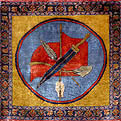



The history of the origin and time period of the first pile-knotted carpets are unclear. At least one modern authority suggests that such pieces were of nomadic origin. Certainly, the rearing of sheep, the prime source of wool, is a traditional nomadic occupation, and the necessity of thick coverings for people having to endure extreme cold would have soon caused the development of the art of weaving to supersede the use of rough animal skins to provide such covering. There are, of course, several references both in ancient scriptures and in classical authors to the art of weaving but no evidence that such references apply to pile carpets. Indeed, on the evidence of fragments found in ancient Egyptian tombs, some dating from the second millenium B.C., we know that various forms of flat-weaving were well developed, but it is probable that pile carpets were unknown. However, we are still at an early stage in the development of carpet studies. Apart from advances in techniques in gathering of scientific data, the modern student is the inheritor of several decades of intense research and of some remarkable discoveries. It must be added, however, that although theoretical structures have been more elaborate and some of the more obvious mistakes of early scholars have been corrected, very little in the way of concrete factual evidence has been added to that at the disposal of many twentieth century scholars.
Early Persian Weaving -
Following the fall of the Sassanian dynasty and the establishment of the Caliphate, the evidence for weaving in Persia becomes clearer, if only because Arab historians and geographers took their task of examining and codifying the peoples of Islam seriously; thus we have a wealth of written material. We know that carpet weaving was carried out at Fars, Majanderan and Gilan to the south-west and, according to Muhddasi writing in the 10th Century in Kainat. Although Arab historians do not describe the kind of weaving, it is safe to assume that pile carpets were made and were almost certainly the products of tribal nomads, who could have moved down from the north of the country in search of fresh pastures.
Abusson Carpets -
The greatest ambition of the French weavers of the seventeenth and eighteenth centuries was to create and maintain a high standard of excellence. A long time was required for apprenticeship, which shows how important the art was considered and the title of "master in tapestry" was a very difficult one to obtain. It is from this system of long apprenticeship and careful teaching and supervision by artists of note, that were brought into existence such remarkably beautiful works of art, as are the abusson rugs of France.